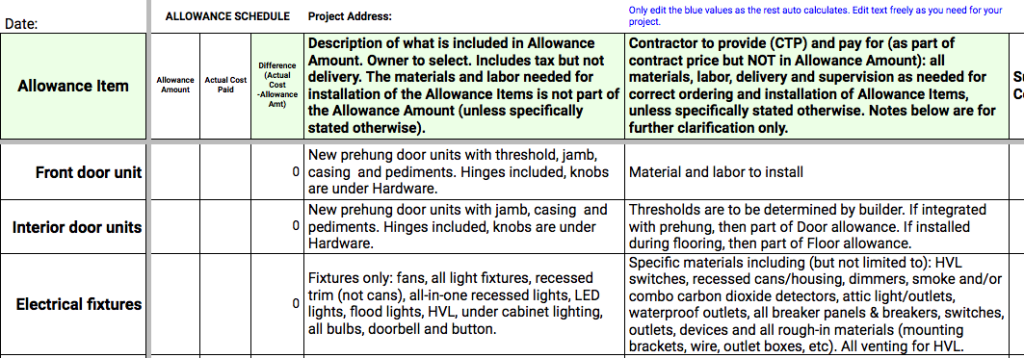Allowances are the #1 key to control costs when used the right way.
Notice that I did not say reduce costs or manage a budget? The reason is that allowances are a strategy to employ, not just a list of items with a price. When used the right way, the owner can actually control costs, minimize change orders and speed up the project.
A typical homeowner usually does not understand the power of utilizing allowances the RIGHT way, as a strategy. It’s a strategy properly employed (and enjoyed) by residential investors all of the time. This article is designed to give you some insight into this powerful tool.
Bear with me as I helicopter up for a minute to talk about why I think it is so crucial to know about the right use and what you can do. I’ll discuss the key details in a minute. First, some context of what the typical home building process is (which is broken) and what you CAN do about it.
Owners experience all sorts of difficulties in their builds: major cost increases, long delays, awful workmanship and more. It’s commonplace (common practice?) based on what I’ve seen from owners sharing their stories in online groups and with my clients. When did $200,000 in total change orders become the new normal? This is NOT how it should be–not by a long shot.
The typical scenario is that the builder provides the construction contract, with an Allowance Schedule attached. The schedule should list all of the items that the owner needs to select, but has not yet finalized. Since the cost of the items is unknown, the builder needs a way to include an amount in his bid (for fixed price contracts) for the items not yet selected.
So, what’s the problem? Isn’t this common practice? It is and it works, for the builder. It should work equally well for the homeowners, which unfortunately is not always the case. Sadly, the typical owner doesn’t have any reason to think there is anything wrong. They simply sign the contract given, with the attached Allowance Schedule, and hope for the best.
I’m a former builder/contractor with 150+ projects under my belt, yet it wasn’t until I became an investor that I had a mindset change. An investor is essentially an owner with all of the same tasks that a homeowner has. As a whole, investors have successful builds–over and over again and do NOT have the huge cost overruns or long delays (which also cost money). They can’t, otherwise they wouldn’t be in business very long. I’m talking about investing in residential homes.
As an example, when I decided to build a new house, on spec (speculation), I hired a general contractor to build it. As a budding developer, I had too much on my plate to also act as the GC. The setup is the same as any owner: I took out a loan, hired an architect, selected all fixtures, made design choices on everything, hired the builder, paid the bills, etc.
The project came in on time, was only $600 over budget and turned out beautifully. That’s how it should go. What are investors doing to control costs and to keep on schedule? Is there some kind of magic going on?
Well, here’s the insider secret– there are 3 key areas regarding allowances. Get these 3 right (plus a few other things) and you’ve gone a long way toward a successful build, which comes in on time and on budget.
1.Allowances Should be Clearly Defined in the Construction Contract
As used in fixed price, lump sum contracts.
The goal here is for the homeowner to understand what an allowance item is and how they are treated–per industry standards. Good places to study are the AIA (American Institute of Architects) and NAHB (National Association of Home Builders). Some variation of the following definition should be included in your contract. I strongly suggest that you engage a qualified attorney to work with you on this language and on your entire contract. Without definitional language in the contract, then what is or isn’t an allowance is left up to your builder to decide, often on-the-fly once construction starts.
Allowances refer to the parts of the house that Owner: (1) must specifically select and (2) the cost is unknown at the time of the signing of the contract, since the final selections have not been made by Owner and (3) the total amount of all Allowances is included in the Contract Price.
An Allowance Amount (a placeholder dollar amount) will be used. It’s a guess as to what the actual cost will be. Later, it will be the Owner’s final selections that determines the Actual Cost of all allowance items. The allowances are shown on an Allowance Schedule, attached as an exhibit to the contract. Actual Cost must be evidenced by a written copy of the actual receipt from the supplier or sub.
I use the word specifically with real purpose. Allowances are literally those items an owner will look at and say ‘I choose that’-that pendant light, bath tub, tile, etc. Contractors often misuse allowances by telling owners that certain items are an allowance item when they should not be. One small example is when builders bill owners for breaker panels and breakers as part of allowances. That is an item an owner would never select.
Don’t leave it up to capricious decisions by your builder. Spell it out in the signed contract, with details and clarity. This is what I mean by clear definitional language. Details matter and the more you have, the better it is for you. Spelled out, in the beginning, closes or narrows the door to misuse.
2. Use a proper Allowance Schedule, full of details
Below are brief snapshots of 3 different allowance schedule scenarios to illustrate what is typically done and other options. Mostly, I’d like to illustrate how having more detail serves the owner in many ways.
A typical builder-provided Allowance Schedule, for the electrical allowance looks like this:
Electrical – $15,000
I shudder when I see a schedule like this with only a heading and an amount, that’s all. It’s unbelievable to me that this is common practice. It leaves the door wide open to whatever interpretation the builder wants it to be. What is even included? Material only? Which materials? Any labor?
With nothing more than ‘Electrical’ do go by in the Allowance Schedule, what happens? Well, basically a builder can send a change order, with whatever they want on it. You might get a CO (change order) for the electrical fixtures that went over budget (which you knew because you selected them) and there are other items thrown in: such as ‘breakers and main panel’ plus ‘switches and outlets’ and…etc. You might think that it seems kinda fishy, but you have nothing to rely on. Once the contract is signed with a schedule like this one (no details) then your only option is to argue with the builder about the unfair CO. Guess who usually wins those arguments? Or perhaps you don’t even argue because you don’t even know that those throw-ins are NOT an allowance item.
All allowance items have 2 parts: fixtures for the owner to select (the allowance items) and installation materials provided by the builder (or the trade through the builder), which are NOT part of the allowance dollar amount but are included in the contract price for the contractor to provide.
In the example of ‘breakers and main panel’ being thrown in as an allowance item, let’s look at what it actually is. It’s electrical for sure. But, owners never select breaker panels. Would you know how many amps, slots and breaker types are in a panel? Of course not. It’s the licensed electrician’s job to make those selections and therefore would not be an allowance. It is part of the installation required to install the electrical but you don’t select it.
This is a teeny example on one electrical item. Think about all of the allowances, some with high dollar amounts (like cabinets or flooring). If there are no real details to guide the allowances then you could be hit with many change orders. No wonder $200k is the new normal. Well, maybe not that much, but who wants to pay for something twice?
A much better Allowance Schedule looks like:
Electrical fixtures – $15,000
Allowance items are fixtures only: fans, all light fixtures, recessed trim (not cans), all-in-one recessed lights, LED lights, floods, HVL (not switch), under cabinet lighting, all bulbs, doorbell and button.
Notice the word ‘fixtures’ and how an actual list of the types of items that are included as allowances could go a long way to closing the door on change orders? It doesn’t solve the problem of a builder throwing in something like a breaker panel because he could call that a ‘fixture’. However, in conjunction with the definitional language in the contract, combined with your very pointed conversations during negotiation of the contract, then those types of what I call ‘random throw-ins’ can be avoided.
BEST type of Allowance Schedule has a column labeled – Contractor to Provide (not an allowance item):
Electrical fixtures – $15,000
Allowance items are fixtures only: fans, all light fixtures, recessed trim (not cans), all-in-one recessed lights, LED lights, floods, HVL (not switch), under cabinet lighting, all bulbs, doorbell and button.
Contractor to Provide as part of contract (not an allowance item): Installation and other materials including (but not limited to): HVL switches, recessed cans/housing, dimmers, smoke and carbon monoxide detectors, attic light/outlets, waterproof outlets, all panels & breakers, switches, outlets, devices and all rough-in materials (mounting brackets, wire, outlet boxes, etc).
Below is a screenshot of only part of the Allowance Schedule ( with lots of detail) that I used when hiring a builder because I simply didn’t want to deal with the b.s. It clearly lays out what is and isn’t included in the allowances. Not every single item is listed (of course), but it does provide some definition as to the types of items and how they are treated. Plus, you’ll also have allowance definitions in the contract.

There is a column that further clarifies what the contractor is to provide for each allowance item, to prevent builders from moving items that should be theirs to provide over to the allowances where essentially you would pay for it twice.
It is unlikely that your builder will furnish an allowance schedule with this level of detail. You can see, though, how you might want to push for having one like this in your contract.
3. Negotiate and Include as Much as You Can
An informed and knowledgeable homeowner can negotiate in an empowered way, asking the right questions and drawing their lines in the sand. Here’s a quick overview of potential ‘gotchas’ which is by no means an all inclusive list. Your exact questions and deal points should come from your further due diligence. Negotiate and discuss with your potential builder how these should be treated.
Include some kind of language in your contract to cover these points:
Included in the Allowance Amount (as shown on the Allowance Schedule):
- All of the points made above, in this article.
- The allowance selections made by the owner and taxes charged for those items.
- In some instances, labor may be included in the Allowance Amount, but it must be clearly stated that this is the case on the Allowance Schedule. Otherwise, it is assumed that no labor is included.
Included in the Contract Price but not in the Allowance Amount:
- Contractor markup for profit and overhead of the allowances.
- All allowance selections shall be purchased by the Contractor.
- Contractor to review owner’s allowance selections for correctness and to coordinate order and delivery.
- Contractor to provide and pay for: cost of delivery, handling and unloading to and at site.
- Contractor to provide and pay for: all installation materials, labor (employee or subcontractor), supervision, insurance, warranties, etc to provide and install the allowance items.
Other points of negotiation:
There is an industry standard which can be seen in the documents by the industry leaders: AIA (American Institute of Architects) and NAHB (Nat’l Association of Home Builders). Do an internet search for their definitions and see the language suggested for insertion into construction contracts. The AIA is included because architects can be hired to supervise construction and when they are, it’s strictly controlled. For those projects, the AIA documents are used. The following is a brief overview of further discussion points and more things to think about.
- ‘Delivery and equipment’ are included in the AIA contract as part of allowances. I don’t include them in my contracts as I’ve had issues with this personally, with builders I hired. ‘Equipment’ is a big term that could be used any way. I feel like contractors can know upfront what’s involved in the delivery, unloading and equipment needs and include it as part of the bid. If there is something tricky, let them bring it up and write up an exclusion that makes sense to both of you.
- Actual cost is the actual cost that the Contractor incurs to purchase the allowance item. If Contractor receives a trade discount then that is deducted from the quote from suppliers/subs to arrive at the actual cost.
- Actual cost must be evidenced by a written copy of the quote/invoice, directly from suppliers and subs (if labor is part of the allowance amount) that are furnishing the item, with transparency as to any trade discount that will be offered to Contractor.
Your potential builder may balk at the trade discount thing and the actual evidence going directly to you. Just know that it can be a point of negotiation for you and your candidate.
Key Takeaways:
- Have a lot of detail for every allowance item. Make sure all items that the Owner selects are included on the Allowance Schedule (there might be 30+ items).
- Do more research to understand how they are used, and importantly, how you can employ them as a strategy for interviewing your potential builder.
- Review all aspects of allowances and negotiate them with your builder, prior to signing the contract. The timing of this negotiation is super important. Unfortunately, the typical timing is what I consider as one of the most problematic areas of the entire home building process. You may want to check out The Most Broken Part of the Home Building Process.
- Work with a qualified attorney to help craft clear definitional language as to what allowances are and further, how they are to be paid, how markup is treated, and even trade discounts should be addressed.
Hope this helps and happy building, Julie You've got this! Remember..
of what you want and how you want it done.![]()

